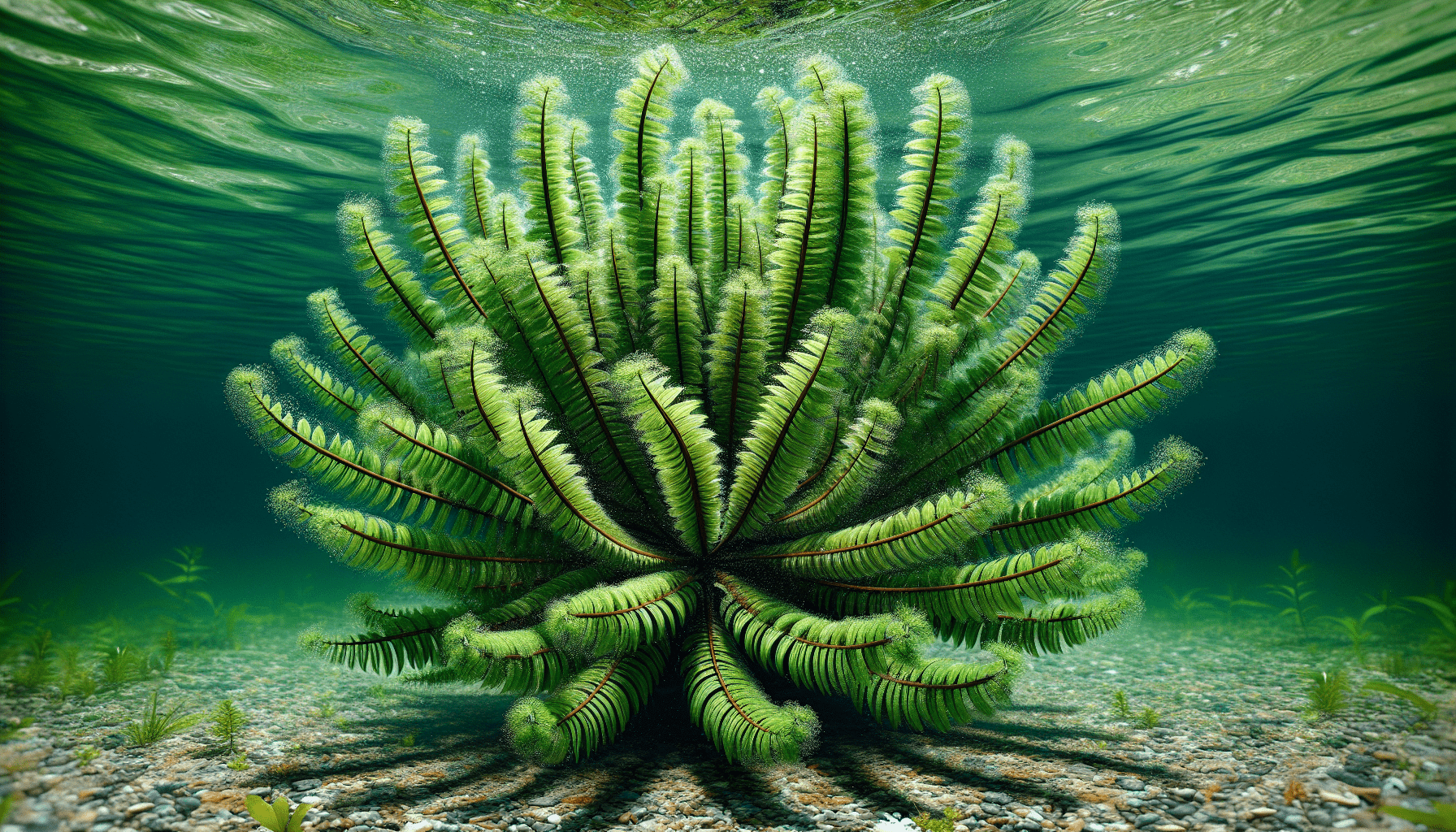In the vast milieu of aquatic flora, a standout species that garners specific attention is the Indian Water Milfoil. As you navigate this article, you will unearth an exhaustive insight into this intriguing water plant’s anatomy, habitats, roles in ecosystems, and its potential benefits and drawbacks. Clarity and depth of knowledge on the ecology of such organisms are paramount, and so, you’ll find an abundance of precise, well-rounded information to satisfy your inquisitive mind. The journey into the underwater world of Indian Water Milfoil awaits your exploration.

Basic Description of Indian Water Milfoil
Official name and classification
The aquatic plant commonly known as Indian Water Milfoil is scientifically known as Myriophyllum aquaticum. It belongs to the family of Haloragaceae.
Physical appearance and characteristics
Indian Water Milfoil is an aquatic plant that is most identifiable by its feather-like underwater leaves. Each whorl has 4 to 5 pairs of leaflets with 12 to 21 thread-like leaflet pairs per leaf. These leaves are typically 1 to 4 cm long, while the entire plant can grow up to 5 meters in length. Small, yellow flowers bloom from the emersed spikes usually in the summer.
Typical habitats
This species of water milfoil thrives in a range of water bodies, including lakes, ponds, and slow-moving rivers. It can grow in water with a wide range of pH and temperature, allowing it to inhabit various environments. It prefers standing water but can tolerate mild currents.
Native Range and Global Distribution
Regions of origin
Indian Water Milfoil is native to the warm temperate regions of South America, particularly Brazil and Argentina. However, it has since spread globally.
Current global spread
Today, the plant can be found in parts of North America, Europe, Australia, Asia, and Africa. In the United States, it is present in most regions, particularly in the midwestern and northeastern states.
Factors driving its distribution
The spread of Indian Water Milfoil is facilitated by its ability to reproduce both sexually and vegetatively. Small fragments of the plant can be dispersed by water currents, wind, or humans, then root where they land to form a new plant. Human activities, such as boating and fishing, tend to speed up this process.
Life Cycle and Growth Habit
Growth stages
Indian Water Milfoil starts as a seed under the sediment, germinating upon suitable condition. It then develops into a young plant that grows rapidly, with stems stretching out across the surface of the water body.
Rate of growth and spread
Primarily a perennial, it can grow year-round in warmer climates, although growth is most rapid in the spring and summer when water temperatures are higher. During its peak growing season, Indian Water Milfoil can cover large areas of a water body in a short amount of time, with each plant capable of producing numerous seed heads.
Seasonal behaviors
In cooler climates, the plant will die back to the sediment level during winter, resuming growth when temperatures rise in the spring.

Ecological Role and Interactions
Partnerships and competitions with other species
Indian Water Milfoil competes for resources with other aquatic plants, often outcompeting them due to its rapid growth rate. This can result in a loss of biodiversity in some cases. However, it also provides important habitats for small invertebrates and fish.
Impact on aquatic ecosystems
Although it provides habitat for some species, Indian Water Milfoil can also become dense enough to inhibit the movement of water and light, adversely affecting other species and changing the aquatic ecosystem’s dynamics.
Known predators and parasites
There are a few known predators of Indian Water Milfoil, including certain species of insects and fish. The milfoil moth and milfoil weevil are some of the insects that are known to utilize the plant as a food source.
Cultural Significance and Uses
Historical uses in native regions
In its areas of origin, Indian Water Milfoil was used in traditional medicine for its supposed healing properties. It was also used for crafting items such as mats due to its flexibility and strength.
Current uses in medicine and industry
Today, the plant is used in homoeopathic medicine for wound healing and reducing inflammation. It is also used in the aquatic plant industry for aquarium decoration.
Symbolic meanings in different cultures
In various cultures, Indian Water Milfoil is a symbol of resilience and adaptability due to its ability to thrive in many different habitats.
Potential Threats and Problems
Invasive behaviors
Perhaps the most significant problem with Indian Water Milfoil is its invasive nature. It can quickly dominate a water body, crowding out native plant species and changing the aquatic environment’s dynamics.
Impact on local fauna and flora
The dense mats can obstruct the movement of fish and other aquatic organisms, sometimes leading to a decrease in biodiversity. Its decaying biomass can also lead to oxygen depletion in the water, affecting the survival of some species.
Known diseases and pests
Indian Water Milfoil is relatively resistant to many diseases and pests. This explains why it can outcompete many other species. However, it is susceptible to the milfoil weevil, which can help to control its growth in certain situations.
Efforts to Control and Manage
Methods of removal or control
The control of Indian Water Milfoil involves physical, chemical, and biological methods. Physical methods include hand-pulling and mechanical harvesting, while chemical control typically involves the use of herbicides. Biological control takes advantage of the plant’s natural predators, such as the aforementioned milfoil weevil.
Legislation and regulations related to its use
In countries like the United States, the sale and transport of Indian Water Milfoil are restricted to prevent its spread. Some states have listed it as a noxious weed, bringing about legal implications for its uncontrolled growth or spread.
Success stories and challenges in control efforts
Despite common measures, controlling Indian Water Milfoil proves to be a challenge due to its rapid growth and spread. However, in certain locations where biological control has been applied, there has been some level of success in controlling its population.
Role in Aquatic Landscaping
Use in home ponds and aquariums
Indian Water Milfoil is popular in aquatic gardening due to its vibrant green color and feathery leaves, which add aesthetic value to home ponds and aquariums.
Considerations for maintenance and containment
When used in private aquariums, it’s essential to prevent Indian Water Milfoil from entering natural water bodies, given its invasive nature. Therefore, comprehensive trimming and disposal practices are crucial.
Compatibility with other plants and animals
Although it can coexist with some aquatic species, it may outcompete other plants for sunlight and nutrients. Therefore, it needs to be managed properly.
Future Directions and Research
Unresolved questions and areas of interest
There are several unresolved questions about Indian Water Milfoil, including understanding the extent of its invasive potency and the potential for native species to adapt to its presence.
Recent findings and breakthroughs
Recent research has focused on understanding the plant at the genetic level, which could lead to more effective control methods.
Potential impacts of climate change and environmental factors
Climate change, particularly warming temperatures, may further facilitate the spread of Indian Water Milfoil, pointing to the need for more robust control strategies.
Ways to Promote Healthy Ecosystems
Tips for preventing the spread of invasive species
Preventing the spread of Indian Water Milfoil and other invasive species requires careful practices, including cleaning boats and equipment to avoid unintentional transportation of plant fragments.
Ways to support conservation efforts
Public engagement in the form of volunteering and donation can significantly support local conservation efforts that aim to contribute to the preservation of biodiversity.
Role of public awareness and education
Perhaps the most effective way to manage invasive species like Indian Water Milfoil is through public awareness and education. By understanding the risks and taking necessary precautions, each individual contributes to the collective effort to maintain a balanced and healthy ecosystem.